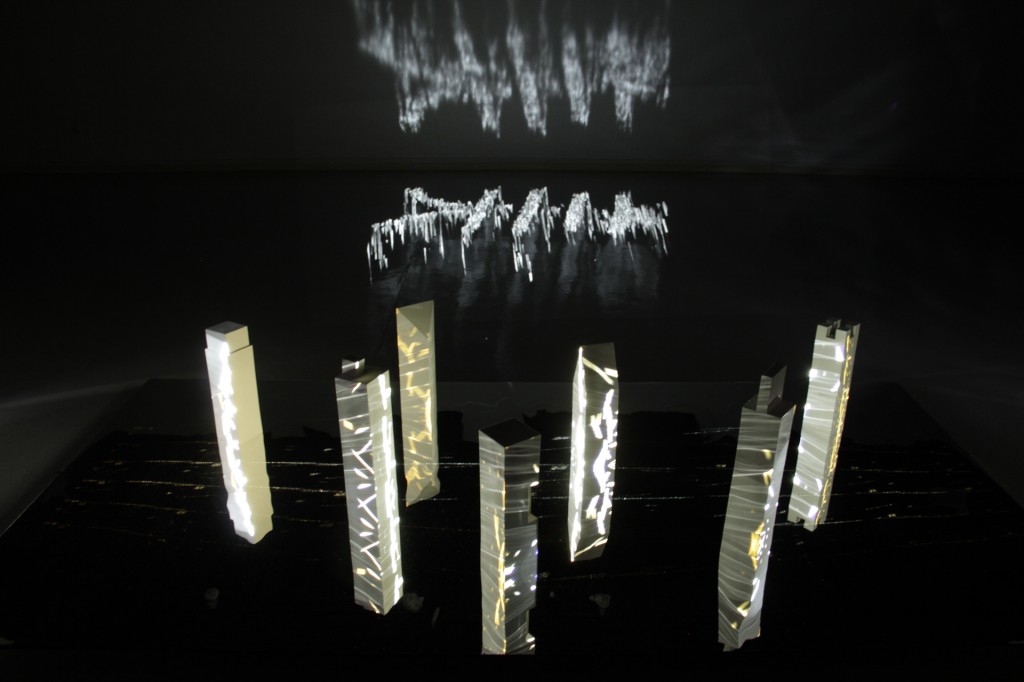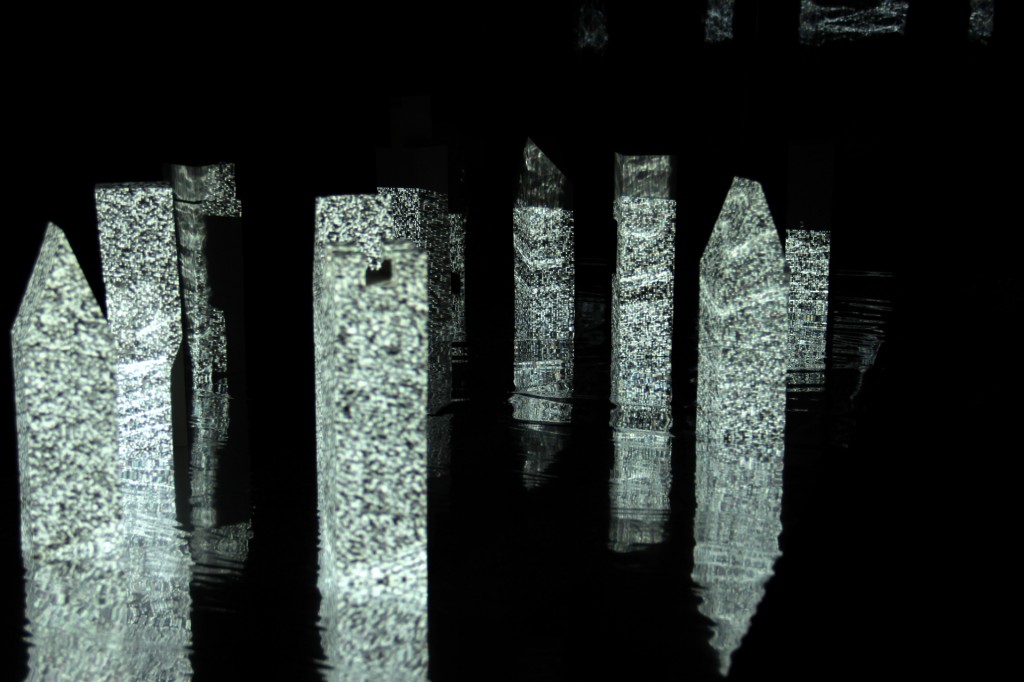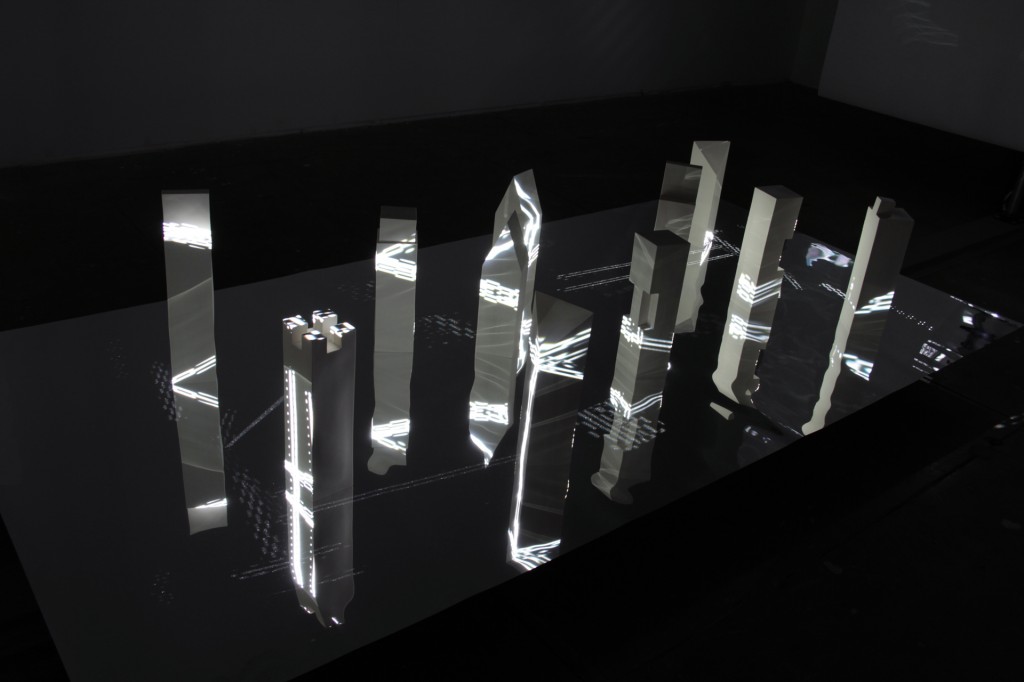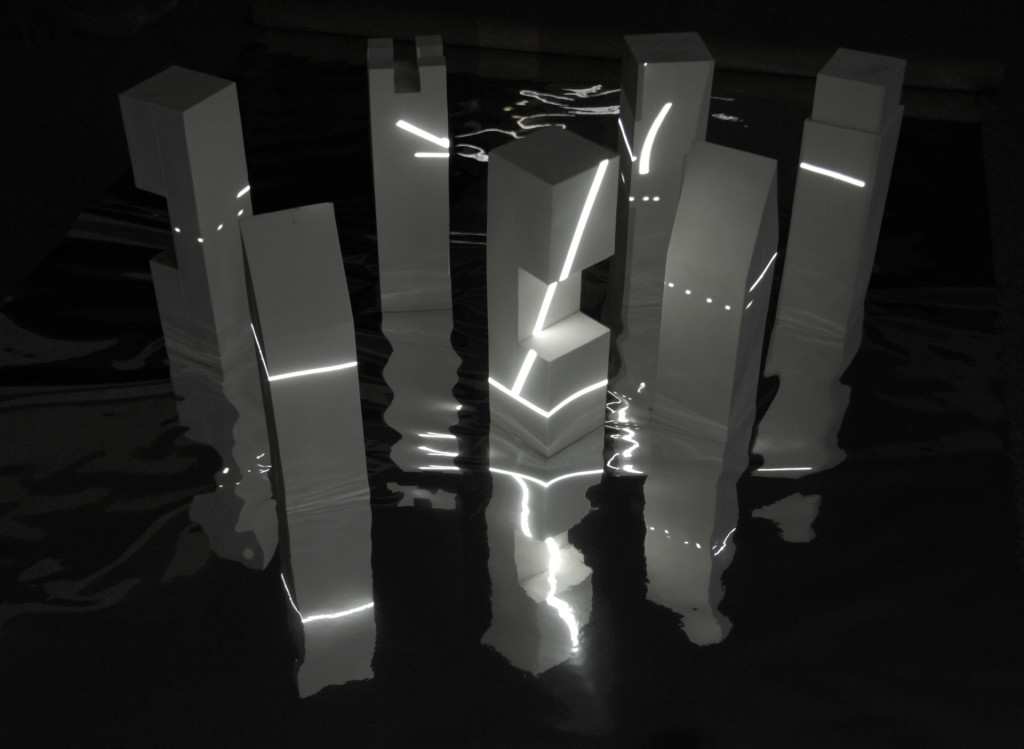Kūkai: Sea and Sky 2012-2015
Kukai, 2013
Collaboration with Robert Campbell
9(h) x 27(w) x 9(d) ft
Porcelain, digital projection, Mylar, wood, paper, speakers, MacMini
7 min 25 sec
We developed ideas of experimental video projection with cast sculptures exploring Mylar which creates afterimages in a reflected underworld. We thought of sky and sea and the parts and pieces of homes washed away during Japan’s recent tsunami, which are floating toward these shores. Kukai is a reference to an influential 8th-century Japanese Buddhist monk. During a long and intense meditation in a cave, he saw the flat horizon where sea and sky meet. He chose the name Kukai for himself. (Ku means Sky, Kai means Sea)
In Beauty projection, we eplored the idea of the simplicity of ideograms and the powerful meanings of kanji characters. The line becomes crystalize, out of focus, points become lines and lines shimmers while rotating in one direction endlessly
“We live directly across Puget Sound from one another- one on Vashon Island, the other in the Old Town district of Tacoma. Sea and sky are omnipresent in our daily imagery: as we watch the floating forms of ships, tankers, and drifting objects, we think of the sea that links the Pacific Northwest with Japan, and the parts and pieces of homes washed away during Japan’s recent tsunami which are now arriving on these shores. The forms that we are reactivating are based on traditional Japanese wood joinery: forms that create bonds that hold parts together. We are basing our approach to combining our respective art forms on the linkage between these general ideas.”
Their first collaborative project was for the 2006 New Works Laboratory, a program between 911 Media Arts Center and the Henry Art Gallery that pairs a visual artist working in traditional media with a digital media artist experimenting with new technologies to co-create and exhibit new and innovative works of art. They created Floating Plaster / City Motion, a multimedia installation comprised of video, audio and cast sculptures incorporating three synchronized video projections. The work integrated sculptural formal aesthetics with architectonic video projections of animated imagery culminating in the creation of an evocative and dynamic installation.
空海 2012・2013
「Kukai」はロバート・キャンベル氏とのコラボレーションの第2弾。キャンベル氏と私はピュージェット湾を挟んで真向かいに位置する、ヴァション島とタコマのオールドタウン地区に住んでいた。海と空は、私たちの日常風景として遍在していた。船やタンカー、漂流物などの浮遊物を見ながら、私たちは太平洋岸北西部と日本の間にある海や、2013年に起こった東日本大震災の津波で流された家の部品や破片がアメリカ西海岸に向かって漂っていることを思い浮かべた。
ポーセリンの形は日本の伝統的な木工芸をベースにしたもので、釘を使わない建築技法で木と木を結合させる組み木をコンセプトにした。ただ結合部分の片方のみの形を使った。組み木ポーセリンと障子風の大きな紙、マイラーと呼ばれる、反射するフィルムを使って、実験的なビデオ・プロジェクションに挑戦した。紙を浸透していく像、反射する地下世界に残像を作り出すマイラー、ポーセリンに投影された灯しぶ、煌めく、揺らめく像、全てがサウンドとともに融合し、深層心理的な情景を作り出した。
タイトルを「空海」とした。空海とは、8世紀に活躍した仏教僧の名前である。空海は、8世紀に活躍した日本の僧侶で、洞窟の中で長い間瞑想していたときに、海と空が出会う平らな水平線を見た時、自分の名前を「空海」とした。
Review by Jen Graves published by The Stranger
A Body Like an Ocean After Japan’s Tsunami: Porcelain, Animation, Sound, and Mylar by Jen Graves
Review by Rosemary Ponnekanti published by The Tacoma News Tribune:
Preview video:
_______________________________________________________________________________________________________________________________________________
Review by Jen Graves, The Stranger
January 17, 2012
SOIL Gallery
Through Jan 28.
A Body Like an Ocean
After Japan’s Tsunami: Porcelain, Animation, Sound, and Mylar
“Ravishing” was the word I had to use the last time I experienced a digital animation rising and setting over a tiny ceramic city in a darkened gallery by the artists Robert Campbell and Yuki Nakamura. That was in 2006, and a new installation based on a similar structure remains beyond the need for or quite the reach of description, especially the way it rolls through time, waves of light patterns passing across faceted and reflecting surfaces in a dazzling stream of constant change.
But certain pieces of information open up new associations. The artists live across Puget Sound from each other, on facing rocks: Campbell on Vashon Island and Nakamura (who is originally from Japan) in Old Town Tacoma. Their mutual view is like an infinite mirrored regress. The artists have written that since the tsunami hit Japan, when they look out at the ships and detritus drifting between them, they can’t help but think about bits and pieces of people’s homes—which are, in fact, making their way toward the American West Coast.
While the artists’ 2006 collaboration,Floating Plaster/City Motion, was founded on hard chunks of land—Nakamura’s sculptures, on which Campbell’s animations appeared, were shaped after the footprints of the Île Saint-Louis and the Île de la Cité in Paris—their new installation has no such anchor. Everything is unmoored. It is called Kūkai: Sea and Sky.
Neon colors animated the sci-fi urbanism of Floating Plaster/City Motion, but Kūkai (a reference to an influential 8th- century Japanese Buddhist monk) is sparkling white, black, and shadow only. The “show” of the animations passing across the porcelain sculptures is multiplied in three other flat surfaces: the pedestal, covered in Mylar, which creates a reflected underworld, and full-height walls built at both ends of the pedestal, where watery afterimages of the Mylar reflections jump and float. A soundtrack adds still another shifting dimension.
Naturally, there’s a memorial quality to Kūkai. It is at least the second wavelike installation incorporating video and sculpture—bringing together the tangible and intangible—by a Seattle artist about the tsunami. The first was I’m Sorry. Thank You. I Love You. by Rumi Koshino, also a native of Japan, with a video of the artist on the Washington Coast facing west, looking out at the ocean as the wind whipped her hair over her face, a large, ominous wave of dark linoleum flooring hanging from the ceiling behind the video screen. Koshino’s body was trapped in a system of repetitive motion that was both frightening and calming. InKūkai, the only bodies are the porcelain sculptures, small, refined monuments that are not monoliths but appear to be parts joined together at tight, neat seams—holding fast while their reflections shiver and mutate. ![]()












